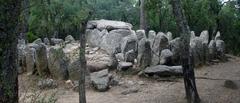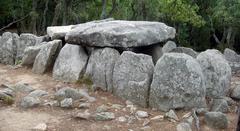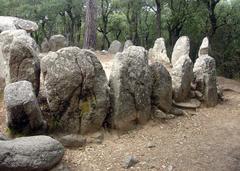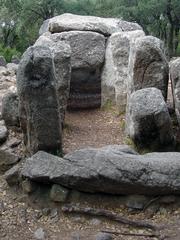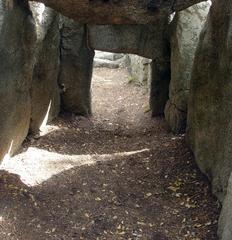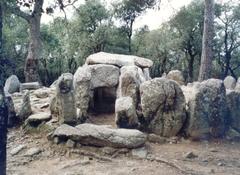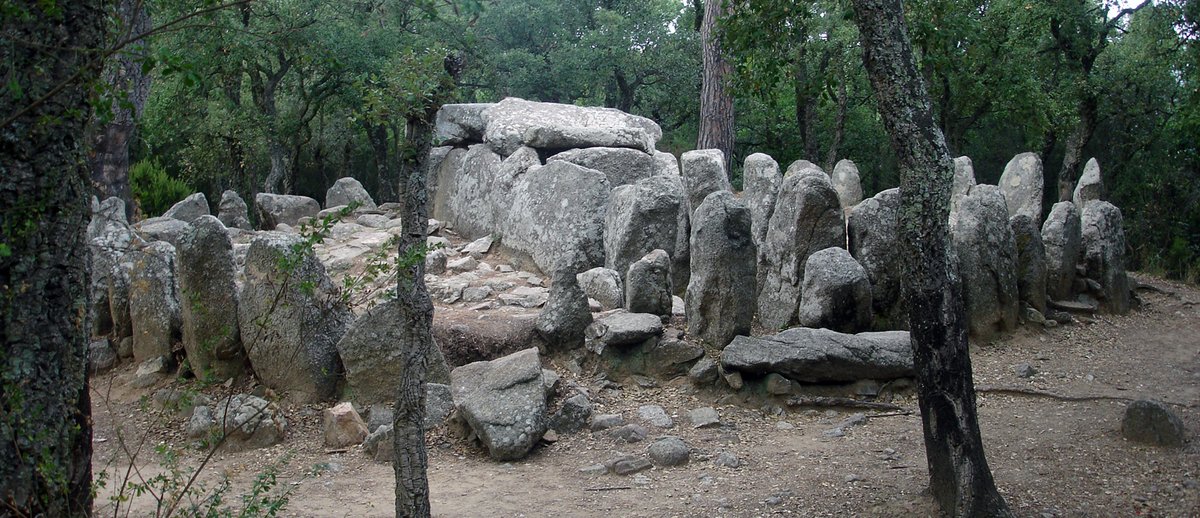
Cova d’en Daina Visiting Hours, Tickets, and Santa Cristina d’Aro Historical Sites Guide
Date: 15/06/2025
Introduction to Cova d’en Daina: History and Visitor Information
Nestled in the scenic landscape outside Santa Cristina d’Aro in Catalonia, Spain, Cova d’en Daina stands as one of the region’s most significant and best-preserved megalithic dolmens. Dating from approximately 2700 to 2200 BCE, this prehistoric monument provides a rare window into the funerary architecture, social organization, and spiritual beliefs of the late Neolithic and early Bronze Age communities of the Iberian Peninsula.
The dolmen features a long, well-preserved corridor and a polygonal burial chamber constructed from imposing granite slabs, all surrounded by an impressive cromlech that once demarcated the monument’s sacred boundary. Archaeological excavations have revealed human remains, pottery, flint tools, and personal ornaments, confirming the dolmen’s role as a collective burial site and a center for prehistoric ritual activity. The southeast-facing entrance, aligned with sunrise, underscores ancient cosmological beliefs.
Cova d’en Daina is freely accessible year-round and is a highlight for history enthusiasts, archaeologists, and cultural travelers. Its proximity to other local historical sites—such as the Menhir de la Murtra and the Església de Sant Martí de Romanyà—makes it an essential stop in any Baix Empordà itinerary. Whether you arrive on foot, by bike, or by car, the monument’s archaeological significance and the natural beauty of the Gavarres mountains promise an enriching experience.
This guide provides up-to-date information on visiting hours, directions, accessibility, guided tours, responsible tourism, and nearby attractions. For the latest details, consult official tourism resources and cultural heritage platforms (Santa Cristina d’Aro Tourism Website, Petit Futé, Pagan Places).
Table of Contents
- Introduction
- Historical Background
- Visiting Information
- Responsible Tourism and Preservation
- Nearby Attractions
- Visuals and Media
- FAQ
- Conclusion
- References
Historical Background
Chronology and Construction
Cova d’en Daina dates from between 2700 and 2200 BCE, during the late Neolithic to early Bronze Age. The site’s core structure is a corridor dolmen, with a 7.6-meter-long passage leading to a polygonal burial chamber about 2.1 meters in diameter. Large granite slabs form both the corridor and chamber, while the entire dolmen was originally covered by a tumulus stretching up to 12 meters wide. The cromlech encircling the monument measures approximately 11 meters in diameter, a rare and well-preserved feature that highlights the site’s ceremonial importance (Petit Futé, Pagan Places).
Archaeological Discoveries
Excavations led by Lluís Esteva Cruañas in 1957 uncovered a range of artifacts: human bones and teeth, flint arrowheads, knife fragments, ceramics, and necklace beads. These finds confirm the dolmen’s use as a collective burial site over multiple generations. Radiocarbon dating places its primary use in the third millennium BCE, and the artifacts suggest both local and long-distance cultural exchanges (Pagan Places).
Cultural and Ritual Significance
The southeast-oriented entrance aligns with regional megalithic cosmological beliefs, emphasizing themes of rebirth and renewal through sunrise. The monument’s construction reflects significant social coordination, and the presence of grave goods indicates a belief in an afterlife and ancestor veneration. Its name, “Cova d’en Daina” (“Cave of the Fallow Deer”), hints at potential mythological or symbolic connections (Petit Futé).
Regional Context
Cova d’en Daina is among the best-preserved dolmens in Catalonia and is part of the broader Gavarres Massif megalithic landscape, which includes menhirs and other dolmens. Declared a national monument in 1931, it remains a vital reference point for understanding the area’s prehistoric past (Pagan Places).
Visiting Information
Visiting Hours and Tickets
- Hours: The site is open year-round. While technically accessible 24/7, visiting between 9:00 AM and 6:00 PM is recommended for safety and optimal experience. During peak seasons or local events, hours may vary—check the official tourism website before your visit.
- Tickets: Admission is free. No ticket or reservation is required, supporting accessible cultural tourism for all visitors.
Directions and Accessibility
- By Car: From Santa Cristina d’Aro, take the GI-664 road and follow signs to Romanyà de la Selva. Parking is available near the site, but spaces are limited.
- By Public Transport: Local buses connect Santa Cristina d’Aro with neighboring towns. From there, a short taxi ride, bike trip, or walk (about 2 km) leads to the dolmen.
- On Foot or Bike: The access trail from Romanyà de la Selva is well-marked and passes through pine and cork oak forests. The path is mostly flat but includes some uneven, natural terrain—wheelchair accessibility is limited, so check locally for assistance options.
Guided Tours
- Local tourism offices and cultural organizations occasionally offer guided tours, which provide detailed context on the dolmen’s history, architecture, and regional significance. Educational workshops and thematic trails are also available; inquire at the Santa Cristina d’Aro Tourist Office for schedules and bookings.
Responsible Tourism and Preservation
As a protected cultural asset and national monument, Cova d’en Daina requires respectful visitor conduct:
- Do not climb or lean on the stones—this causes erosion and damage (visitsantacristina.cat).
- Stay on marked paths to avoid disturbing archaeological features and local flora (patrimoni.gencat.cat).
- Carry out all litter; there are no bins on site.
- Do not touch or remove artifacts—leave everything as you found it.
- No fires, smoking, or drone flights (unless prior permission is obtained).
- Support local conservation efforts through donations or by participating in educational activities.
For emergencies or to report vandalism, contact local authorities or the tourist office ([email protected]).
Nearby Attractions
Enhance your visit to Cova d’en Daina by exploring these nearby sites:
- Menhir de la Murtra: A prehistoric standing stone, part of the region’s megalithic network (Petit Futé).
- Església de Sant Martí de Romanyà: A 10th–11th-century pre-Romanesque church in the nearby village.
- Monastery of Solius: A modern Cistercian monastery known for its nativity scene collection.
- Costa Brava Beaches: The Mediterranean coast is a short drive away, with renowned beaches and coves.
- Hiking and Cycling: The Via Verde (Greenway) and local trails provide scenic routes through the Gavarres mountains.
Visuals and Media
Images courtesy of Catalonia Tourism Board.
Frequently Asked Questions (FAQ)
Q: What are the visiting hours for Cova d’en Daina?
A: The site is open year-round. Daylight hours (9:00 AM–6:00 PM) are recommended. Check official updates.
Q: Is there an entrance fee?
A: No, visiting Cova d’en Daina is free of charge.
Q: How do I get there from Barcelona?
A: Take a train or bus to Girona, then local transport or taxi to Santa Cristina d’Aro. From there, drive, bike, or walk to the dolmen.
Q: Are guided tours available?
A: Yes, check with local tourism offices for availability and schedules.
Q: Is the site wheelchair accessible?
A: Accessibility is limited due to natural terrain. Contact the tourist office for the latest information.
Q: Are drones allowed?
A: No, unless special permission is granted.
Conclusion
Cova d’en Daina stands as a testament to the ingenuity and spiritual life of Catalonia’s ancient inhabitants. Its remarkable preservation and open access make it a must-visit site for anyone interested in archaeology, history, or cultural heritage. By respecting the site and following responsible tourism practices, you help ensure that this extraordinary monument endures for generations to come.
To further enrich your experience, consider joining a guided tour or using digital resources like the Audiala app for interactive maps and audio guides. For more information on local heritage, visit the Santa Cristina d’Aro Tourism Website.
References
- Santa Cristina d’Aro Tourism Website
- Petit Futé
- Pagan Places
- visitsantacristina.cat
- patrimoni.gencat.cat
- costabrava.org
